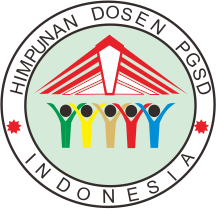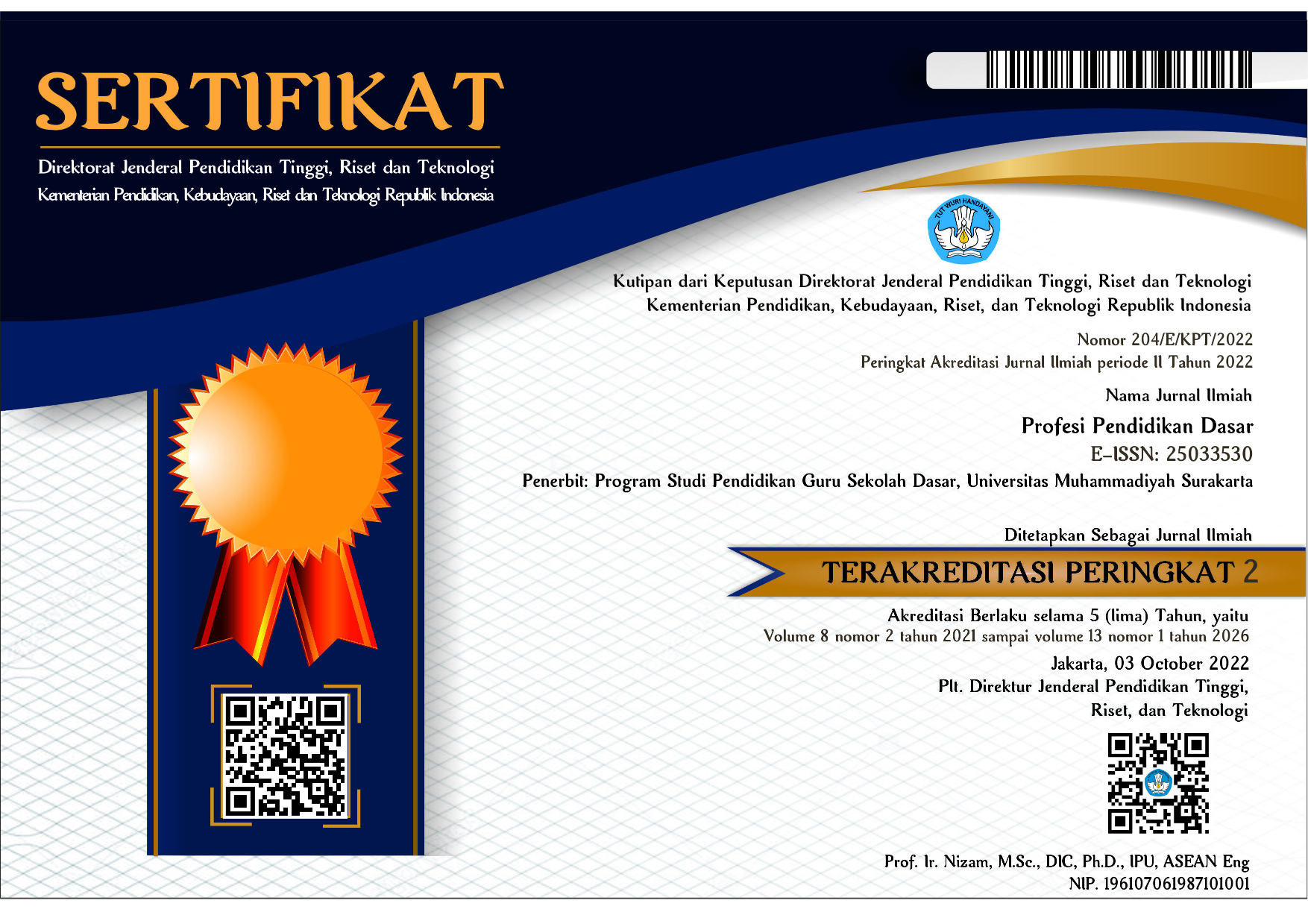ANALISIS KELAYAKAN BUKU PENILAIAN (BUPENA) DISEKOLAH DASAR
Fitri Puji Rahmawati(1*), Efi Rusdiyani(2)(1) (ID SINTA = 5982158) Elementary School Teacher and Education (PGSD), Faculty of Teacher Training and Education (FKIP), Universitas Muhammadiyah Surakarta.
(2)
(*) Corresponding Author
Abstract
Keywords
Full Text:
PDFReferences
Afandi, ’Alia N. H., & Aka, K. A. (2019). Pengembangan dan Validasi Instrumen Analisis Buku Tematik-Terpadu pada Kurikulum 2013. Jurnal Pendidikan Dasar Nusantara, 4(2), 199-219. https://doi.org/10.29407/jpdn.v4i2.13520
Agustina, Eka Sofia. 2011. Telaah Buku Teks Bahasa Indonesia. Bandarlampung: Universitas Lampung.
Akbar, Sa’dun. 2013. Instrumen Perangkat Pembelajaran. Bandung: Usaha Rosda
Arini Ulfah Hidayati.2017. Melatih Keterampilan Berpikir Tingkat Tinggi Dalam Pembelajaran Matematika Pada Siswa Sekolah Dasar. Jurnal Pendidikan dan Pembelajaran Dasar. Vol 4 No 2. Di akses pada http://ejournal.radenintan.ac.id/index.php/terampil/article/view/2222
Elias, M. J., Parker, S. J., Kash, V. M., Weissberg, R. P., & O’Brien, M. U. (2008). Social and emotional learning, moral education, and character education: A comparative analysis and a view toward convergence. Handbook of moral and character education, 248-266.
Gelfman, E., Podstrigich, A., and Losinskaya, R. 2004. On the problem of typology and functions of school texts. Discussion Group14, Focus on the Development and Research of Mathematics Textbooks. ICME X, Copenhagen, Denmark, July.
Hayat, Bahrul dan Suhendra Yusuf. 2010. Benchmark Internasional Mutu Pendidikan. Jakarta: Bumi Aksara.
Komalasari, K. 2014. Pembelajaran Kontekstual: Konsep dan Aplikasi. Bandung: Refika Aditama.
Kripendorff, K. 2004. Content Analysis: An Introduction to Its Methodology. (2nd ed.). Thousand Oaks: Sage Publication, Inc.
Laksono, Kisyani. 2008. Membaca 2. Jakartaa: Universitas Terbuka.
L.W. Anderson dan D.R. Krathwohl. 2001. A Taxonomy for Learning, Teaching, and Assesing; A revision of Bloom’s Taxonomy of Education Objectives. Addison Wesley Lonman Inc. New Yor. https://eduq.info/xmlui/handle/11515/18345
Masnur Muslich. 2010. TEXT BOOK, Penulisan Buku Teks. Jakarta: Bumi Aksara.
Mikk, J. 2000. Textbook: Research and Writing. Oxford: Lang
Moleong, Lexy J. 2017. Metode Penelitian Kualitatif. Bandung: PT. Remaja Rosdakarya Offset
Nasser, R. 2014. “A Methodological and Scientifi c Approach to Developing a Research Agenda in Education”.Journal of Applied Sciences, 1-8.
Niron, M.D., Budiningsih, C.A., & Pujiriyanto. 2013. “Rujukan Integratif dalam Pelaksanaan Pendidikan Karakter di Sekolah Dasar”. Jurnal Kependidikan, 43(1), 19-31. Di akses pada https://journal.uny.ac.id/index.php/jk/article/view/2247
Richardson, R. C., Tolson, H., Huang, T. Y., & Lee, Y. H. (2009). Character education: Lessons for teaching social and emotional competence. Children & Schools, 31(2), 71-78. https://academic.oup.com/cs/article-abstract/31/2/71/503731
Senem, B. Y. 2013. Content Analysis of 9th Grade Physics Curriculum, Textbook, Lessons with Respect to Science Process Skills. Unpublished Doctoral Dissertation. The Middle East Technical University, Ankara.
Soeroso, Hadi. 2011. Telaah Pengembangan Kurikulum dan Penyusunan KTSP. Semarang: IKIP PGRI Press.
Widodo, Mulyanto. 2015. Teori Belajar Bahasa. Bandar Lampung: Universitas Lampung.
Yasa.Ketut Ngurah.2013. Kecermatan Formula Keterbacaan Sebagai Penentu Keefektifan Teks. Jurnal Pendidikan dan Pengajaran. Vol46 (3), Hal:238-245. Di akses pada http://pgsd.fip.um.ac.id/wp-content/uploads/2017/01/19.pdf
Yuliana &, Yudi Budianti (2015). Pengaruh Penggunaan Media Konkret Terhadap Hasil Belajar Siswa Pada Mata Pelajaran Matematika Kelas II Sekolah Dasar Negeri Babelan Kota 06 Kecamatan Babelan Kabupaten Bekasi. Jurnal Pendidikan Dasar pedagogik Vol. III, No. 1. Di akses pada http://jurnal.unismabekasi.ac.id/index.php/pedagogik/article/view/1258
Yusuf, Syamsu. 2011. Psikologi Perkembangan Anak dan Remaja. Bandung: Remaja Rosdakarya
Article Metrics
Abstract view(s): 1366 time(s)PDF: 1314 time(s)
Refbacks
- There are currently no refbacks.


















